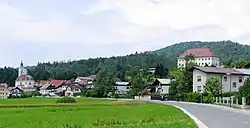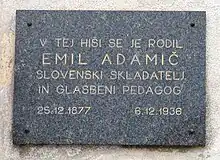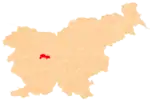Dobrova | |
|---|---|
 Dobrova with the parish church (left), the rectory and convent (top right), and Dobrova Hill in the background | |
 Dobrova Location in Slovenia | |
| Coordinates: 46°3′11.89″N 14°24′52.01″E / 46.0533028°N 14.4144472°E | |
| Country | |
| Traditional region | Upper Carniola |
| Statistical region | Central Slovenia |
| Municipality | Dobrova–Polhov Gradec |
| Area | |
| • Total | 7.93 km2 (3.06 sq mi) |
| Elevation | 310.3 m (1,018.0 ft) |
| Population (2020) | |
| • Total | 921 |
| • Density | 120/km2 (300/sq mi) |
| [1] | |
Dobrova (pronounced [ˈdoːbɾɔʋa]; German: Dobrawa[2][3]) is a clustered settlement northwest of Ljubljana in the Upper Carniola region of Slovenia. It is the administrative centre of the Municipality of Dobrova–Polhov Gradec.[4] It lies on the road from Ljubljana to Polhov Gradec at the point where roads split off to Horjul to the southwest and to Šentvid, Ljubljana to the northeast. It extends along the flat area to the northeast up to the Gradaščica River and encompasses much of Dobrova Hill (Slovene: Dobrovski hrib,[5] 603 m; also known as Vrhe Hill[6] or Jazbina Hill[7]) to the southwest. Bezenica Creek, Broad Creek (Slovene: Široki potok), and Ječnik Creek, left tributaries of the Horjulščica River, flow through the hills west of the settlement.[8][9][10] Dobrova includes the hamlets of Pod Kotom (Pod kotom) northwest of the main settlement and Graben southwest of the main settlement.[5]
Name
Dobrova was first mentioned in German written sources in 1252 as in Harde (literally, 'in the woods'), in 1354 as cze Hard ('at the woods'), and in 1490 as bey der Hurd ('by the woods'), semantically corresponding to the Slovene name. The name Dobrova is derived from Common Slavic *dǫbrova 'place where there is a deciduous or oak forest', in turn derived from *dǫbъ 'deciduous tree, oak'. Like similar names (e.g., Dobrovce, Dobrovnik, Zadobrova), it originally referred to the local vegetation.[11] In the past it was known as Dobrawa in German.[2][3]
History
The name of nearby Gradišče Hill (cf. grad 'castle') south of Dobrova, across the Horjulščica River, hints at late Roman or even earlier settlement of the area.[5] A school was founded in Dobrova in 1844 in the sexton's house, which was later adapted for school needs.[5]
Second World War
On 8 July 1942 the Partisans attacked an Italian stronghold at the rectory in Dobrova. On the following day the village was burned.[5] On 20 November 1942 the Partisans abducted and killed seven people from the nearby village of Zaklanec in the Broad Creek Gorge.[12][13] On 27 January 1943 the Partisans burned down the newly built six-year school in Dobrova.[14][15]
Church

The parish church in Dobrova is dedicated to the Assumption of Mary and was one of the most important pilgrimage churches in Carniola. A church or chapel has stood at this site since before 1231, when the structure there was enlarged. According to Johann Weikhard von Valvasor, this is one of the oldest church sites in Slovenia, and according to some sources it may even date to as early as 970.
Dobrova was originally subordinate to the proto-parish of Šentvid nad Ljubljano. Because of Dobrova's distance from Šentvid and to better serve the increasingly large number of pilgrims that traveled to Dobrova, a vicariate was established in Dobrova in 1723, and it was made an independent parish in 1784. The vicariate already included the churches in Gabrje, Hruševo, and Brezje pri Dobrovi as chapels of ease, and Podsmreka was added to the new parish in 1784.[16]
The current church was built between 1711 and 1716, largely due to the efforts of Baron Franc Bogomir Polhograjski, at that time the cathedral canon and dean in Ljubljana. The church was designed by the architect Gregor Maček Sr. (1664–1725). The height of the bell tower was increased in 1752. The interior frescos were painted by Matija Bradaška (1852–1915) and the main altar is a work by Matija Tomc (1814–1885). The church was formerly known as the Our Lady of the Hazels Church (cerkev Marije v leščevju) due to the hazels that still grow there.[17] The church has been protected as a cultural heritage monument since 2009.[18]
Notable people
Notable people that were born in, lived in, or had family connections to Dobrova include:
- Emil Adamič (1877–1936), composer
- Jože Marinko (1893–1975), poet[19]
- Joe Sutter (1921–2016), the "father of the Boeing 747," son of Franz Suhadolz (1879–1945), an emigrant from Dobrova
Gallery
 House in Dobrova where the composer Emil Adamič was born
House in Dobrova where the composer Emil Adamič was born Plaque: "The Slovenian composer and music teacher Emil Adamič was born in this house (25 Dec. 1877 – 6 Dec. 1936)"
Plaque: "The Slovenian composer and music teacher Emil Adamič was born in this house (25 Dec. 1877 – 6 Dec. 1936)" Rectory and convent in Dobrova
Rectory and convent in Dobrova Wayside shrine at the intersection of the roads to Polhov Gradec and Stranska Vas
Wayside shrine at the intersection of the roads to Polhov Gradec and Stranska Vas
References
- ↑ Statistical Office of the Republic of Slovenia
- 1 2 Intelligenzblatt zur Laibacher Zeitung, no. 141. 24 November 1849, p. 20.
- 1 2 Leksikon občin kraljestev in dežel zastopanih v državnem zboru, vol. 6: Kranjsko. 1906. Vienna: C. Kr. Dvorna in Državna Tiskarna, p. 106.
- ↑ Dobrova–Polhov Gradec municipal site Archived 16 January 2014 at the Wayback Machine
- 1 2 3 4 5 Savnik, Roman, ed. 1971. Krajevni leksikon Slovenije, vol. 2. Ljubljana: Državna založba Slovenije. p. 406.
- ↑ Vrhe Hill on Geopedia (in Slovene)
- ↑ Klemenčič, Marijan M., & Darko Ogrin (eds.). 2005. Atlas Slovenije. Ljubljana: Mladinska knjiga, p. 121.
- ↑ Bezenica Creek on Geopedia (in Slovene)
- ↑ Broad Creek on Geopedia (in Slovene)
- ↑ Ječnik Creek on Geopedia (in Slovene)
- ↑ Snoj, Marko. 2009. Etimološki slovar slovenskih zemljepisnih imen. Ljubljana: Modrijan and Založba ZRC, p. 114.
- ↑ Zaveza no. 62 (21 July 2011) Archived 29 June 2012 at the Wayback Machine (in Slovene)
- ↑ Graves of the Broad Creek Gorge victims at Find A Grave
- ↑ "Krivda rdeče fronte" (in Slovenian). Archived from the original on 21 December 2014. Retrieved 31 May 2010.
- ↑ Javornik, Mirko. 1944. Črne bukve: o delu komunistične osvobodilne fronte proti slovenskemu narodu. Ljubljana: Slovenski dom, pp. 166, 175. (in Slovene)
- ↑ "Marija v leščevju. Zgodovina božje poti in opis cerkve". Župnija Dobrova. Retrieved 4 June 2021.
- ↑ Hribernik, Mirjam (2006). Možnosti razvoja občine Dobrova-Polhov Gradec s poudarkom na turizmu [Development Opportunities for the Municipality of Dobrova–Polhov Gradec with an Emphasis on Tourism] (PDF) (in Slovenian). Faculty of Arts, University of Ljubljana. pp. 68–69.
- ↑ Slovenian Ministry of Culture register of national heritage Archived 13 June 2015 at the Wayback Machine reference number ešd 1771
- ↑ Orožen, Božena. 1991. Slovstveni in kulturnozgodovinski vodnik: Štajerska z obrobjem. Ljubljana: Zavod Republike Slovenije za šolstvo in šport, p. 74.
External links
 Media related to Dobrova at Wikimedia Commons
Media related to Dobrova at Wikimedia Commons- Dobrova on Geopedia
- Dobrova Cemetery at Find A Grave
